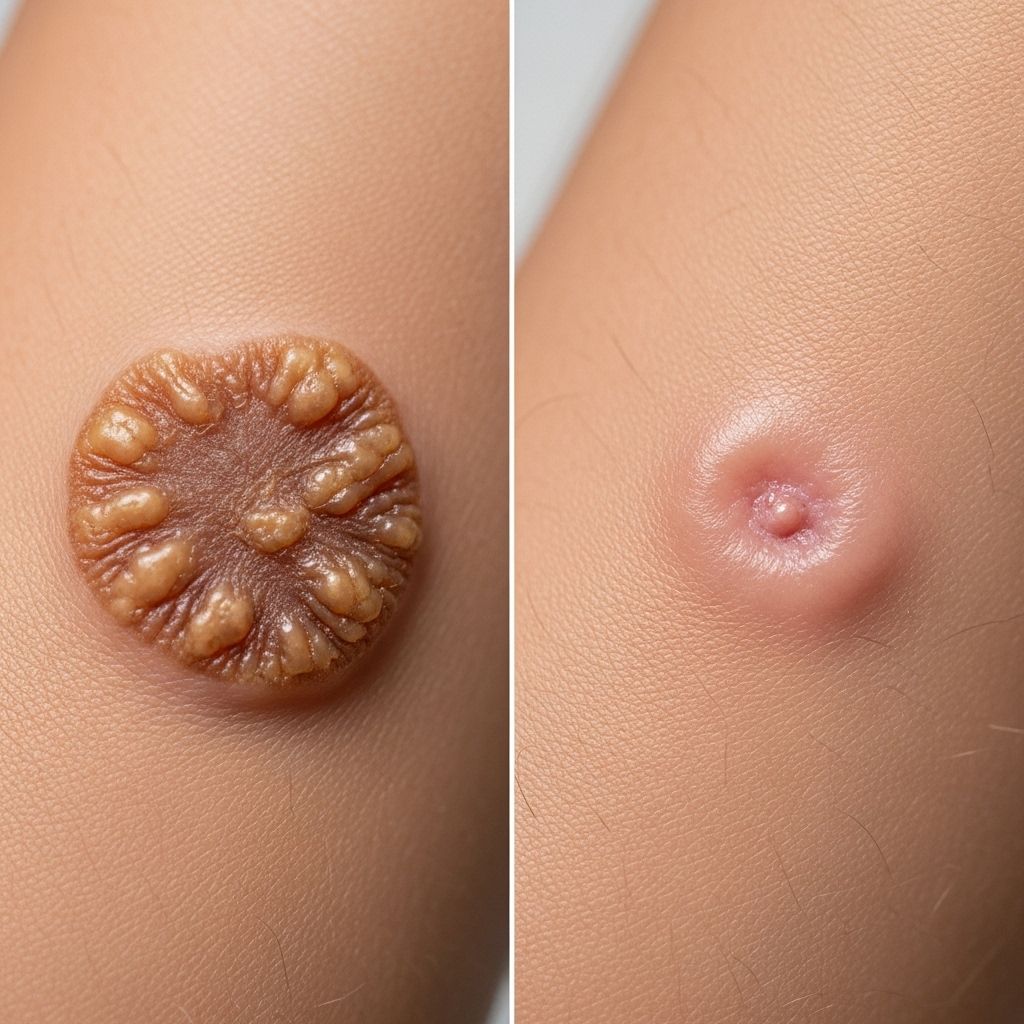Seborrheic Keratosis vs. Basal Cell Carcinoma: A Comprehensive Guide
Distinguishing harmless patches from malignant lesions brings clarity and reassurance.

Table of Content
- Brief Introduction
- Seborrheic Keratosis
- Basal Cell Carcinoma
- Diagnosing and Differentiating
- Treatment Options
- Frequently Asked Questions (FAQs)
Brief Introduction
Both Seborrheic Keratosis and Basal Cell Carcinoma are common skin conditions that can often be mistaken for one another due to their similar appearance. However, they are distinct in terms of their causes, symptoms, and implications for health.
Seborrheic Keratosis
What is Seborrheic Keratosis?
Seborrheic keratoses are benign (noncancerous) growths that appear during the aging process. They are dark, waxy-looking patches that can appear anywhere on the body, often resembling scabs or moles. Despite their appearance, seborrheic keratoses are not a risk factor for skin cancer and do not transform into cancerous lesions.
Symptoms and Characteristics
- Appearance: Dark, waxy, or scab-like patches on the skin.
- Colors: Varying shades from white to black.
- Locations: Can occur anywhere on the body.
- Symptoms: Generally, no symptoms are present, but they can become inflamed or irritated.
Causes and Risk Factors
The exact cause of seborrheic keratoses is unknown, but they are more common in older adults. Ultraviolet (UV) radiation from the sun or tanning beds may contribute to their formation over time.
Basal Cell Carcinoma
What is Basal Cell Carcinoma?
Basal Cell Carcinoma (BCC) is the most common form of skin cancer, originating from the basal cell layer of the epidermis. It is typically slow-growing and rarely spreads to other parts of the body. However, if left untreated, BCC can cause significant disfigurement and functional problems.
Symptoms and Characteristics
- Appearance: Typically appears as a small, firm, pink or red bump or patch.
- Locations: Commonly found on sun-exposed areas like the face, neck, and arms.
- Symptoms: May bleed or ooze, and can be painful if irritated.
Causes and Risk Factors
The primary cause of BCC is prolonged exposure to UV radiation, primarily from the sun or tanning beds. Fair skin, family history of skin cancer, and a weakened immune system are additional risk factors.
Diagnosing and Differentiating
Diagnosing seborrheic keratosis and basal cell carcinoma involves a physical examination by a dermatologist and may require a biopsy to confirm the diagnosis. Seborrheic keratosis can be distinguished by its appearance and lack of cancerous cells under microscopic examination.
Visual Differences
| Condition | Appearance | Location | Symptoms | Implications |
|---|---|---|---|---|
| Seborrheic Keratosis | Dark, waxy patches | Anywhere on the body | Generally none, but can become irritated | Benign, non-cancerous |
| Basal Cell Carcinoma | Small, firm, pink or red bump | Sun-exposed areas | May bleed or ooze | Cancerous, potentially invasive if untreated |
Treatment Options
Seborrheic keratoses are typically not treated unless they are irritated or cause cosmetic concerns. On the other hand, basal cell carcinoma requires timely medical intervention to prevent complications.
Treatment for Seborrheic Keratosis
- Cryotherapy: Freezing the growth with liquid nitrogen.
- Shave Excision: Removing the growth with a surgical tool.
- Hydrogen Peroxide: Applying as a topical treatment for minor lesions.
Treatment for Basal Cell Carcinoma
- Surgical Excision: Removing the tumor along with a margin of healthy skin.
- Mohs Surgery: A precise surgical technique to remove the tumor layer by layer.
- Photodynamic Therapy: Using light and a medication to kill cancer cells.
Frequently Asked Questions (FAQs)
Q: Can Seborrheic Keratosis become cancerous?
A: No, Seborrheic Keratosis is benign and does not transform into cancer.
Q: How is Basal Cell Carcinoma diagnosed?
A: Diagnosis typically involves a physical examination and biopsy by a dermatologist.
Q: What are the treatment options for Basal Cell Carcinoma?
A: Treatment options include surgical excision, Mohs surgery, and photodynamic therapy.
Q: Can Seborrheic Keratosis be prevented?
A: While prevention is unclear, protecting the skin from sun exposure may reduce the formation of new growths.
Q: Is Basal Cell Carcinoma life-threatening?
A: Generally not, but it can cause significant disfigurement if left untreated.
References
- https://www.cancer.org/cancer/types/basal-and-squamous-cell-skin-cancer/about/what-is-basal-and-squamous-cell.html
- https://www.medicalnewstoday.com/articles/320742
- https://pmc.ncbi.nlm.nih.gov/articles/PMC5905929/
- https://www.miamidermcenter.com/2024/02/09/basal-cell-carcinoma-vs-other-skin-conditions-how-to-differentiate/
- https://www.mohssurgerymd.com/blog/recognizing-a-seborrheic-keratosis-and-why-it-matters
- https://www.frontiersin.org/journals/oncology/articles/10.3389/fonc.2025.1507322/full
- https://dermnetnz.org/topics/seborrhoeic-keratosis
Read full bio of medha deb












